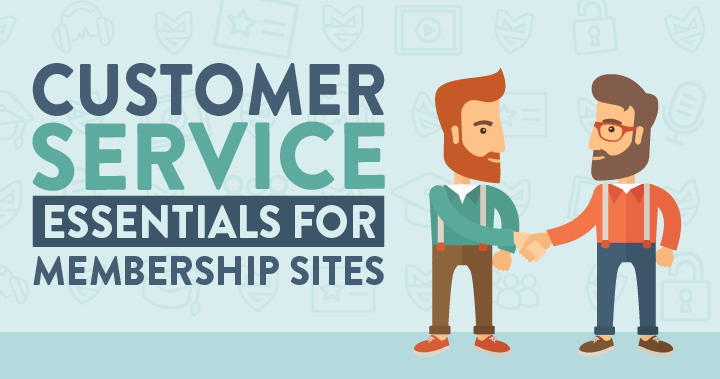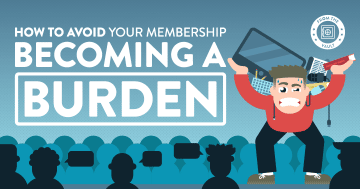Customer service is at the heart of the member experience.
No matter how great your membership site is, you’re going to have members contacting you for additional support at some point.
Whether it’s a problem with their account, difficulty accessing a feature, or just wanting to let you know how much they’re enjoying your site (those are my favourite!), members will want to get in touch with you, and it’s important to have an easy way for them to do so if needed.
Providing your members with good customer service is an easy way to elevate their experience of your site, and similarly a bad customer service experience will quickly turn their opinion of your membership sour.
It doesn’t have to be difficult to get customer service right for your membership site though- in fact there’s just 4 steps you need:
Step 1: Consider the different reasons members might get in touch
The first thing to do when thinking about customer service is to consider the reasons that a member might want to get in touch with you in the first place.
Support requests might include:
- Difficulty accessing their membership
- A feature on the site not working
- A question about something in your content
- Wanting to cancel their account
- Providing you with feedback (good or bad!)
You may also want to account for any pre-sales questions as well.
Once you know the reasons why someone might be trying to get in touch with you, it’s much easier to put some processes in place to deal with the most common reasons.
Step 2: Offer a variety of different ways to contact you
It’s a good idea to offer a couple of different ways for members to get in touch with you rather than just relying on one option.
This can make it much quicker and easier for your members to get support when needed, as well as providing a backup should one of your options be unavailable for some reason.
Contact options include:
- Contact Form
- Support/Ticket desk
- Phone
- Forum
- Live Chat
- In app messaging
For the Membership Academy we have a contact form that can be easily accessed from the member dashboard (this contact page is also available to non-members with pre-sales questions), we make use of Intercom (an onsite messaging system) to allow members to send us direct messages on the site itself from any page that they are on, and we also have our member forum.
Something we’re frequently asked is whether having different support methods like this causes confusion or makes us ‘too accessible’.
We’ve never found this to be the case however.
Members will typically use the forum for content related questions, Intercom if they run into an issue on the site and the contact form if they have a more general questions about the site or have an account issue.
Having a variety of different contact methods available makes it simple for our members to get in touch with us, and means that we can deal with any issues quickly and easily.
Step 3: Have clear customer service guidelines
It’s a good idea to have some guidelines in place over ‘acceptable use’ of your customer support services.
Whilst most people won’t need these, it helps to avoid any confusion or potential issues such as someone sending you emails asking for personal feedback.
Be clear about what your customer service and support channels are to be used for – for example can members send questions about a lesson or just questions about their account?
More importantly however, it’s a good idea to set expectations as to when someone is likely to hear back from you.
If you only answer emails between 9am and 5pm EST Monday to Friday, make sure that that’s clear so that people aren’t left waiting to hear back from you or wondering whether you’ve got their message at all.
Being clear on availability makes everyone’s lives much easier – by managing expectations, your members will have a reasonable idea of when they might hear back from you, and you won’t feel like you need to be glued to your phone 24/7 in case a member emails.
But while it’s good to have these boundaries in place, it can also be good to break them when needed.
If a member sends you an issue on a Saturday morning, and you have the ability to deal with it there and then rather than waiting until your ‘office hours’ on Monday then do so – they’ll appreciate it being dealt with faster than they expected and feel like they have received great service from you.
Step 4: Answer any queries within 24 hours if possible
The quicker you can deal with any support issues the better.
I’m not saying you have to respond within 10 minutes of receiving an email, but leaving a response for 3 or 4 days probably isn’t going to be appreciated, especially if the issue is to do with a problem accessing your site.
You may think that this goes without saying and it’s natural to respond to support queries promptly, but you’d be surprised!
I joined a site once where I never received my login details.
It took the owner 8 days to respond to my support request and give me login access.

Actual footage of me waiting for those login details!
Can you guess how that left me feeling as a paying member (and how long I stayed a member for?)!
We all know that life happens of course, and you can’t – and shouldn’t – be on hand 24/7.
If you know that you’re going to be offline for an extended period of time (outside of the guidelines you established in step 3) then make sure you have an alternative in place such as a VA who can respond to emails for you – or even an out of office email so that someone at least knows what to expect.
Again, managing expectations goes a long way and can make the difference between good customer service and bad.
Ways to streamline your customer service:
The busier your membership site gets, the more time it can take you to deal with customer service issues.
There’s a few things you can do however to streamline your customer service and ensure that members still receive the support that they need, without it eating into the time that you need for things like content creation.
Some options to consider:
- A tour or welcome video
- FAQs or Knowledge base
- A VA or Community Manager
- Self Service Features
Create a tour or welcome video
If you know that you get a lot of questions from new members about how to do certain things or access certain features of your membership then why not try creating a new member tour or welcome video that walks new members through your site?
You can even show members how to do things like set up their member profile and start a course.
This sort of orientation content should be part of your new member onboarding process.
This can massively help with acclimatising members to your site and cutting down ‘where do I find…’ style support questions.
Develop FAQs or a knowledgebase
If there’s certain questions that come up time and again then consider having an FAQ section (you could put this on your contact page so it’s easily accessible) that can give people these answers without them even needing to contact you.
This could include questions like ‘how do I cancel my account’, ‘where do I change my password’, ‘how can I download videos’ and so on.
An even more in-depth solution is a complete Knowledge Base, and you’ll see these frequently included with plugins and themes.
If you have a lot of different elements to your site, or a lot of features that may need explaining, then this approach can be more comprehensive than just an FAQ section, and having a search feature as part of this can make it really quick and easy for members to get the answers that they need.
Hire a Virtual Assistant or Community Manager
It may actually be that it’s time to hand the customer service reigns over to someone else so that you can focus on tasks that only you can do, such as creating your member content.
In order for this to work really well it’s a good idea to have particular processes and systems in place so that your VA or Manager knows what to do without having to run things by you.
So, have a set cancellation process in place, a set refund process, a set response for if someone is having difficulty accessing the site and so on.
You won’t be able to account for everything, but the more systematised you can make things the easier it will be to hand control of your customer service to someone else.
Self Service Features
The more ‘self service’ you can make your membership site for members the better.
It saves your members time and it saves you time too!
A good example of this is cancellations – if your member can cancel their membership themselves with 1-click of a button on their account page, then this is so much simpler than them having to email support to request a cancellation (or to ask how to cancel).
It’s also really helpful if you can enable members to change their billing details from their own account – not only will this cut down customer service emails but it will reduce failed payments too.
Other tasks that you might want to make self service for members include things like upgrading (or downgrading) their membership or even just changing their email address or password.
Dealing with difficult members
Difficult members are something every membership site owner dreads. You’ll typically find that these are a rarer occurrence than you may expect, particular where community is involved as often your members will “self-police”.
However, if a member is being difficult, or rude, or aggressive, in their communications with you then I find the best approach is to breathe, smile and respond politely – but if needed also let them know that their behaviour isn’t acceptable and that if it continues they will be removed from the membership.
Give them the benefit of the doubt initially – sometimes what we read as rude is simply someone typing quickly on their mobile phone or attempting to multi-task!
Think about what you will do if someone requests a refund outside of any guarantee period that you have, as this is most likely going to be where ‘difficult’ members occur – even if the fault is their own.
The choices here are really just to stick to your ‘no refunds’ guns or to provide a refund anyway in order to create good will.
What you choose is entirely up to you, but it’s a good idea to consider your response to this situation before it actually occurs so you don’t feel rushed to make a spur of the moment call.
Good customer service can actually help to turn awkward situations and difficult members into a positive, and increase the likelihood that someone’s lasting impression of your membership is a good one.
At the end of the day, the key to good customer service for your membership site is simply to have clear channels of communication in place and respond quickly and helpfully to any requests.
And, if in doubt, consider what you would want if roles were reversed and you were the member.
Thank You For Listening
We really appreciate you chosing to listen to us and for supporting the podcast. If you enjoyed today's show, please share it using the social media buttons on this page.
We would also be eternally grateful if you would consider taking a minute or two to leave an honest review and rating for the show in iTunes. They're extremely helpful when it comes to reaching our audience and we read each and every one personally!
Finally, don't forget to subscribe to the podcast in iTunes to make sure that you never miss an episode





